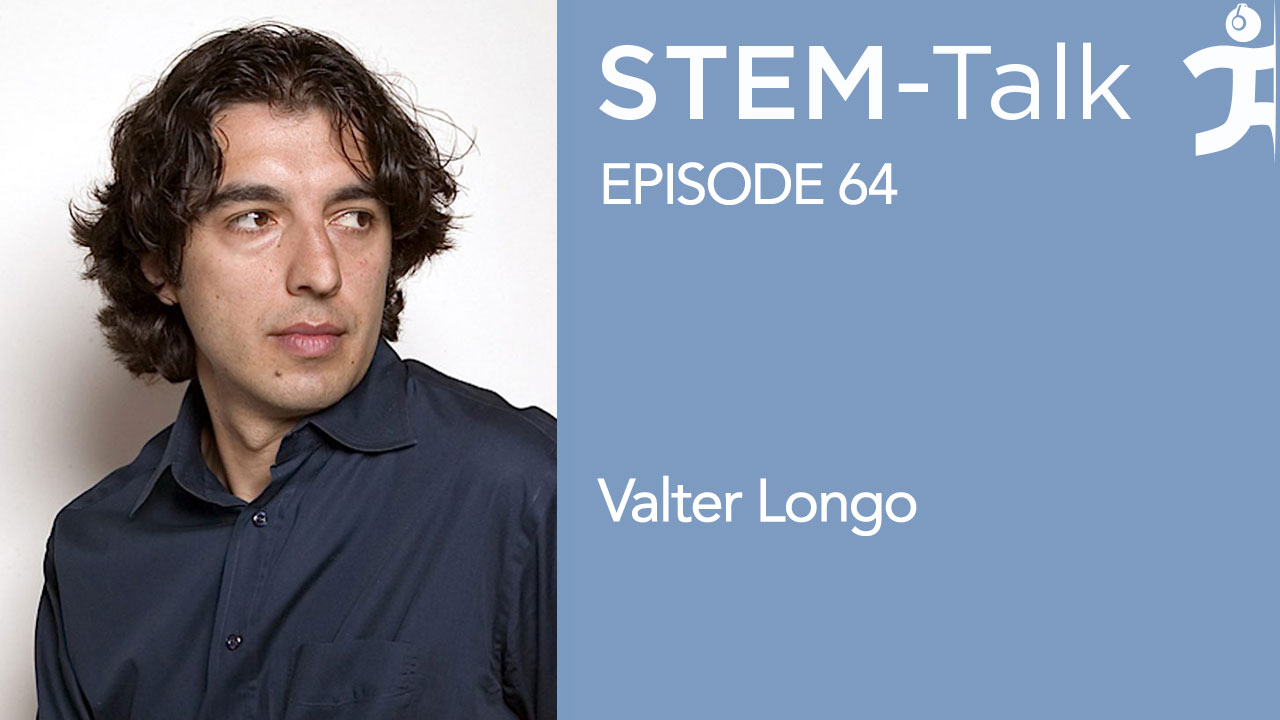STEM-Talk
Episode 64: Valter Longo talks about the fasting-mimicking diet and the keys to longevity
// May 22, 2018

Today’s episode features Dr. Valter Longo, director of the Longevity Institute at the University of Southern California.
Valter is best known for his research on stem cells and aging as well as his fasting-mimicking diet. Often referred to as FMD, the diet is intended to avoid the downsides of fasting while reaping the health benefits of a calorie-restrictive diet.
Over a 25-year career, Valter has published numerous papers about the ways specific diets can activate stem cells and promote regeneration and rejuvenation in multiple organs to reduce the risk for diabetes, cancer, Alzheimer’s and heart disease.
He writes about this research and diet in a book that was released earlier this year, “The Longevity Diet: Discover the New Science Behind Stem Cell Activation and Regeneration to Slow Aging, Fight Disease and Optimizer Weight.” The book details an easy-to-follow everyday diet that is combined with short periods of the fasting-mimicking diet. Valter says the diet has the potential to help people live healthier and longer lives.
Valter is a native of Genoa, Italy and moved Chicago when he was 16. He received his bachelor’s of science degree at the University of North Texas in 1992 and his Ph.D. at UCLA in 1997.
Links:
Longevity Center website:
http://longevityinstitute.usc.edu
Longo’s USC faculty page:
http://gero.usc.edu/faculty/longo/
“The Longevity Diet”:
https://amzn.to/2s1fcky
A periodic diet that mimics fasting promotes multi-system regeneration:
https://www.ncbi.nlm.nih.gov/pmc/articles/PMC4509734/
Fasting-Mimicking Diet Promotes Ngn3-Driven β-Cell Regeneration:
https://www.cell.com/cell/fulltext/S0092-8674(17)30130-7
Fasting-mimicking diet and markers/risk factors for aging:
http://stm.sciencemag.org/content/9/377/eaai8700
Prolon FMD website:
https://prolonfmd.com/fasting-mimicking-diet/?doing_wp_cron=1526216346.5062971115112304687500
Show notes:
2:24: Dawn opens the interview by mentioning that Valter was born and raised in Genoa, Italy, the hometown of Christopher Columbus. She asks if reports of him driving his neighbors mad playing Dire Straits, Jimmy Hendricks and Pink Floyd on his electric guitar as a youth are accurate.
2:43: Dawn asks Valter what his parents said when he tried to talk them into letting him go to London to be a rock star when he was 12 years old?
3:10: Valter left home when he was 16 to go visit an aunt in Chicago, but ended up staying in Chicago to go to school and play music. Dawn asks what that was like?
3:49: Dawn comments on how in addition to being exposed to some of the best blues music in the world, Valter also was exposed to some of the unhealthiest food in the world. Valter then talks about what he refers to as “the heart-attack diet.”
4:48: Dawn asks what lead Valter to attend the University of North Texas College of Music.
5:30: Valter joined the Army Reserve to help pay for college and ended up assigned to a battalion of Army tankers. Ken asks Valter what that was like.
6:15: Dawn asks if it’s true that the idea of directing a marching band lead Valter to switch majors as a sophomore.
7:07: Dawn comments on how not many jazz performance majors, who have never taken a biology course, decide to switch their major to biochemistry. She asks Valter what the people in the biochemistry department had to say about that.
8:04: Dawn mentions that when Valter was five years old, he saw his ailing grandfather pass away. She asks him to talk about that experience and the role it played in his decision to study aging.
9:14: Dawn mentions that after switching over to biochemistry and graduating from college in 1992, Valter headed to UCLA, which at the time was one of the world’s leading centers of longevity research. She asks Valter how that opportunity came about.
10:22: Ken brings up Valter’s work at UCLA in the lab of the pathologist, Roy Walford. Valter studied the effects of caloric restriction in the lab and Ken asks Valter to talk about what he learned.
11:25: Dawn comments that while in Walford’s lab, Valter made two important discoveries using a method that he invented. Dawns asks him to describe the discoveries.
13:20: Dawn asks Valter what led him to do his post-doc work at the University of Southern California, and what the focus of his research was at USC.
14:04: Dawn asks what it was like to study in a community of dwarves in Ecuador, a group of people who lack the receptor for the growth hormone, which is known as Laron syndrome. Valter talks what he learned from that experience.
16:08: Ken notes that these dwarves seem to be nearly immune to cancer and diabetes. Accidents, convulsive disorders and alcohol deaths, however, account for 50 percent of their mortality. Among non-dwarf relatives, these same causes of mortality account for just three percent of deaths. Ken asks Valter what causes this big disparity.
17:54: Dawn recounts that Valter went on to become a professor of gerontology and biological sciences at USC, and that in 2011 he became the director of the Longevity Institute. She goes on to say that the institute is not just interested in the idea of people living longer, but also understanding how people can live healthier longer. She asks if Valter could give some background on the institute and the type of research it does.
19:27: Ken notes that Valter believes it is smarter to intervene on aging itself, rather than try to prevent and treat diseases one by one as they come up. Ken asks Valter to talk about that.
21:04: Dawn mentions that Valter has traveled the world studying people in “blue zones,” areas of the world with the longest-lived populations. She goes on to mention that because of his time with centenarians, Valter concluded that in order to understand how people can live healthy lives, one needs to go beyond the scientific, epidemiological, and clinical studies, and investigate actual populations that age successfully.
23:11: Ken mentions that Valter had the opportunity to know Emma Romano, who lived to 117 and was reportedly the oldest person in the world. He goes on to mention that Emma’s sisters also lived into their 90s and some of the sisters made it to 100. These women, it would seem, were rare individuals who could eat and do just about anything they wanted and still age successfully. Ken asks how much of a role genetics played in their lifespan.
24:30: Dawn shifts gears to talk about Valter’s book “The Longevity Diet,” which is the outgrowth of Valter’s 30 years of research on aging. The book describes a daily nutritional regiment that is combined with the “fasting mimicking diet.” Dawn asks if Valter could define the fasting-mimicking diet.
27:02: Ken asks Valter what it is about the fasting-mimicking diet that actually mimics fasting.
28:38: Dawn asks if one should measure markers such as glucose, ketones, insulin, and IGF-1 while undergoing the fasting mimicking diet.
29:42: Dawn asks if the implementation of the diet requires a doctor’s supervision.
30:46: Dawn inquires as to what a typical fasting-mimicking diet meal looks like.
31:13: Dawn asks how Valter arrived at the 5-day period as the necessary time to experience the benefits of the fasting-mimicking diet.
32:22: Dawn asks if there are populations that Valter wouldn’t recommend the diet to.
33:33: Shifting gears, Ken asks if one can have coffee on the fasting-mimicking diet, mentioning that Valter’s grandfather and Emma Romano likely enjoyed espresso.
35:01: Ken mentions that Valter has said that skipping breakfast increases overall morality and asks him to explain this.
36:42: Dawn mentions that Valter has published a number of papers that indicate that cycles of fasting and refeeding can cause multisystem regeneration and rejuvenation that lead to extended health spans and effects ranging from those on the immune system to the nervous system to muscles. She asks Valter to talk about this.
38:27: Ken asks if Valter could share what he calls the “five pillars of longevity.”
41:31: Dawn asks about the mechanism by which fasting causes an unfavorable environment for cancer cells.
44:24: Ken brings up metformin as an example of a compound that can artificially induce some of the benefits of fasting in the body.
45:45: Ken returns to IGF-1, asking what role it plays in both health and disease.
46:31: Ken brings up the epidemiology research done in the 2011 meta-analysis by Burgers Atoll which showed that both low and high IGF-1 concentrations are associated with increased mortality, essentially showing that the hazard ratio appears U shaped in that both ends of the spectrum are hazardous to a person’s health. Ken asks if there is a sweet spot, or if Valter considers it to be a case of the lower the better, or if it somewhat depends on a person’s age?
48:42: Ken mentions that something that tends to be overlooked in discussing IGF-1 is that fasting, the ketogenic diet, and other such things increase the receptor sensitivity for IGF-1. Thus, even at a relatively low level, the effects would not be the same for someone not in a state of ketosis.
49:52: Dawn asks if protein intake is the only dietary factor involved in regulating IGF-1 levels.
50:21: Ken mentions that Valter’s 2014 cell metabolism paper leveled the risk firmly at the door of IGF-1 concentrations. Ken brings up that IGF-1 regulation of metabolism, however, is more about the interactions of IGF-1 with binding proteins. Ken asks how much IGF binding proteins play a role in IGF.
51:42: Dawn brings up that in 2014 Valter published a study with Levine Addal that said, “We provide convincing evidence that a high-protein diet, particularly if the proteins are derived from animals, is nearly as bad as smoking for your health.” She asks Valter to explain the process of coming to that conclusion.
52:33: Following up on that question, Ken mentions that the risks purported in the paper were relative risks, not absolute risks. In other words, the relative risk of dying from cancer in the high-protein group was roughly four times that of the low-protein group, but the absolute change in risk was maybe half of one percent. Ken points out that depending on how one presents the risk, it could lead to different headlines.
53:26: Ken comments on how he believes the presentation of risk to be misleading, because the change in absolute risk was so negligible as to be noise.
53:58: Ken, returning to protein, mentions that protein intake is complex and multifactorial. Ken asks Valter if the epidemiological research that has been discussed in the interview is able to tease out the important nuances and variables.
56:43: Dawn mentions that Valter often receives emails from people diagnosed with cancer, autoimmune disorders and neurodegenerative diseases who are seeking options beyond the standard treatments offered by their doctors. Valter says this was a key reason he established the Create Cures Foundation, and goes on to give an overview of the foundation and how it is funded.
58:01: Interview ends.






